Experiencing a great love for hydrangeas, today many of our gardeners grow various varieties of this plant on their plots. Among them there are treelike and oak-leaved forms, as well as paniculate and petiolate, serrate and large-leaved. Moreover, in recent years, the species diversity of hydrangeas has been replenished with new attractive varieties.
Among them, the panicle hydrangea vanilla freise is of particular interest. It is very popular due to its simplicity in care, therefore, even without having great skills and experience in growing ornamental plants, every flower lover can enjoy the unforgettable flowering of this plant in the first season. But still, in order for the efforts to meet the expectations of the grower, it must be grown according to certain rules.
Content
general characteristics
In the scientific world, the Vanilla Fraise variety sounds rather unusual - Hydrangea paniculata Vanille Fraise. This plant loves lighted areas, although it grows just as well under partial shade conditions. Lime soils have a depressing effect on hydrangea, therefore, it is best to plant it on organic-rich, moist and slightly acidic soils, where it can show itself in all its glory. When choosing a place for planting Vanilla Freise hydrangea, you must take into account the size that it will reach in adulthood. Indeed, over time, a small stalk will turn into a fairly large hydrangea bush with a height of 1.5 meters, having a crown with a section of 2 meters.
- the decorative character of panicle hydrangea is given by young erect shoots of red color. However, during flowering, they begin to bend, as flowers begin to press on them, and this is what allows the bush to acquire its usual spherical shape;
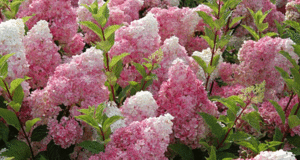 During growth, the variety Vanilla Freise develops dense, dark green, oblong leaves, which have pubescence, which causes associations with velvet. In adult specimens, a rather small root system with many branches grows;
During growth, the variety Vanilla Freise develops dense, dark green, oblong leaves, which have pubescence, which causes associations with velvet. In adult specimens, a rather small root system with many branches grows;- Panicle hydrangea is a cold-resistant crop, so it can be grown without shelter in areas where the temperature drops to 29 degrees Celsius in winter. However, if you rely on the experience of specialists, then in the middle zone of our country it is recommended to grow this hydrangea variety with a shelter in order to avoid freezing of the branches.
Flowering features
In the family of panicle hydrangeas, the Vanilla Fraz variety stands out for its attractive appearance. If you provide her with appropriate care, then she will be able to thank the gardener with her beautiful buds... Under favorable conditions, it grows large, up to 40 cm long and up to 30 cm wide, pyramidal inflorescences, which can easily be mistaken for a cone with vanilla-strawberry ice cream.
The flowering period of hydrangea paniculate vanille fraise is short: the first flowers bloom in July and continue to decorate the site until September. Of the features of the variety, it is worth highlighting a unique color range.... In the first weeks of flowering, the hydrangea has a snow-white color, but later you can see how a dark pink border begins to form along the edge of the petals.
 In the future, the lower part of the inflorescence is modified, acquiring a strawberry-red hue, which eventually becomes pale pink. The top of the inflorescence remains unchanged and therefore retains white. This property is inherent only in the panicle hydrangea Vanilla Fraz. Subject to the rules of planting and caring for the plant, the gardener will have the opportunity to contemplate all the beauty of this plant. At the same time, the frequency and quality of pruning can greatly affect the number and size of blossoming buds.
In the future, the lower part of the inflorescence is modified, acquiring a strawberry-red hue, which eventually becomes pale pink. The top of the inflorescence remains unchanged and therefore retains white. This property is inherent only in the panicle hydrangea Vanilla Fraz. Subject to the rules of planting and caring for the plant, the gardener will have the opportunity to contemplate all the beauty of this plant. At the same time, the frequency and quality of pruning can greatly affect the number and size of blossoming buds.
When to plant vanille fraise hydrangea?
Experts recommend planting Vanilla Fraise hydrangea in mid-spring conditions. In this case the plant will have enough time to get used to new conditions, as well as for the formation of a complete root system. However, this can be achieved if the planting and grooming techniques are followed exactly.
Planting agricultural technology Vanilla fries
First, 30 x 30 x 30 cm holes are prepared for the seedlings. Plants need to be placed not closer than 1 meter from each other... When the holes are ready, they should be filled with a mixture of ½ bucket of peat mixed with rotted compost or humus. Finally, the hole needs to be watered.
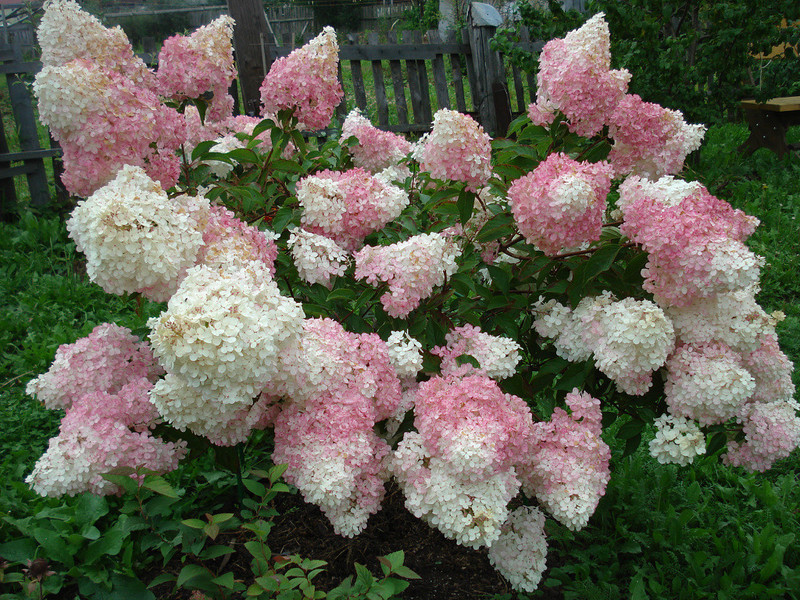
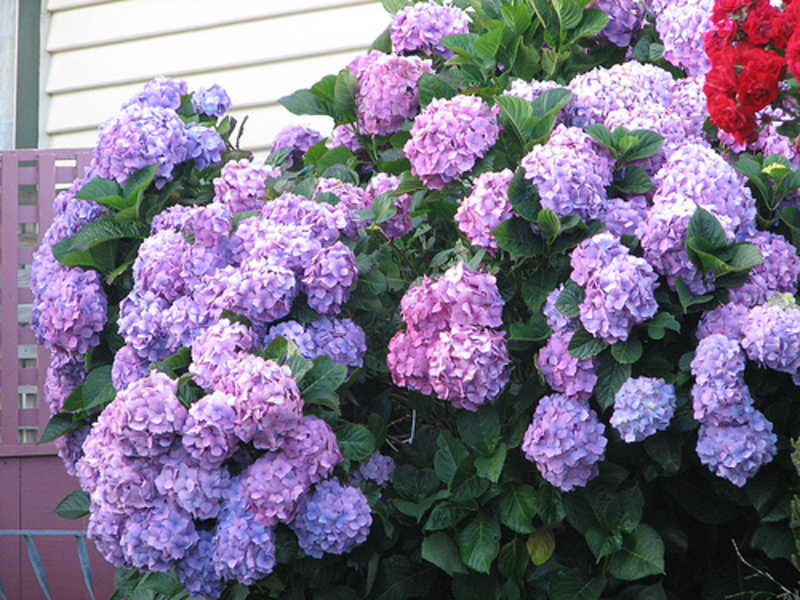
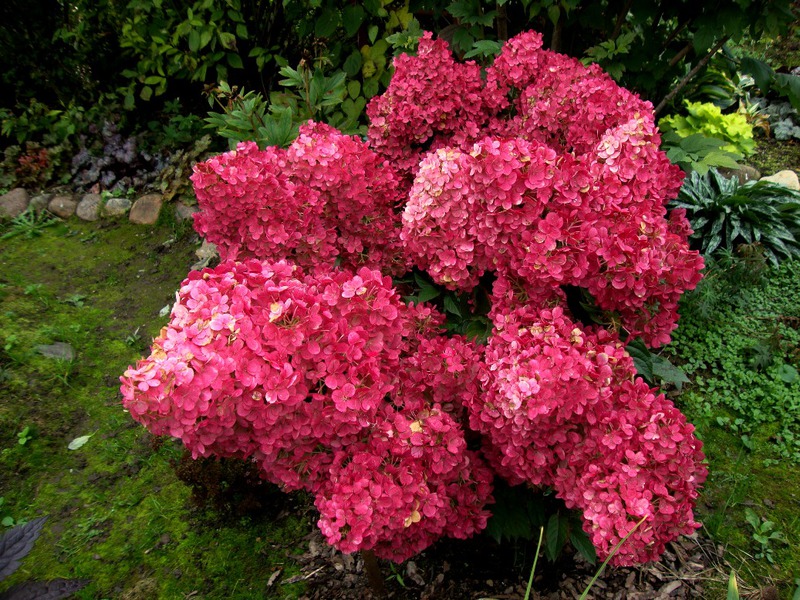
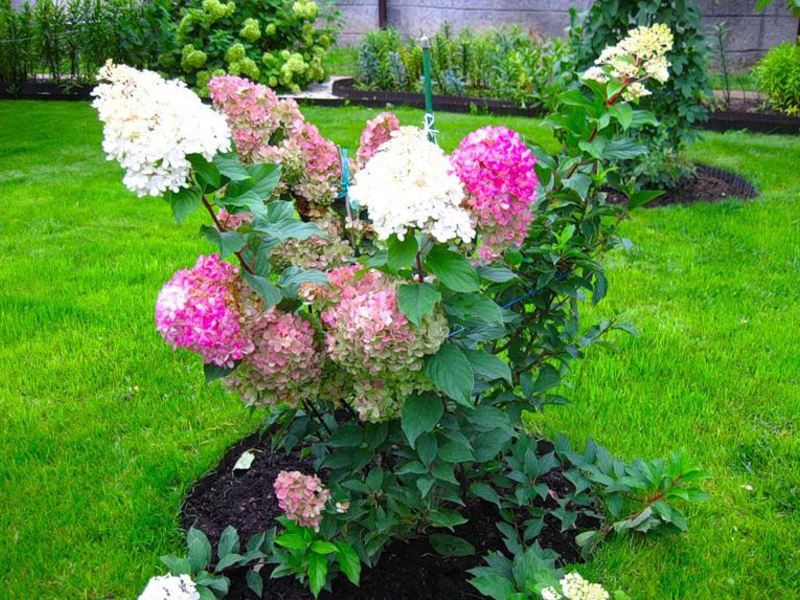
After that, seedlings of vanilla fraise hydrangea are transferred into the holes, after having straightened their roots. Garden soil is poured on top, making sure that the root collar is not hidden. Along the perimeter of the roots, it is necessary to compact the soil to avoid the formation of "air pockets".
Having finished planting the seedlings, it is imperative to water the holes and loosen the surface layer of the soil. If the hydrangea is planted in sunny and hot weather, otherwise it will require shelter, for example, spunbond or other available material. It will help protect young plants from burns.
Where can you put Vanilla Frazy?
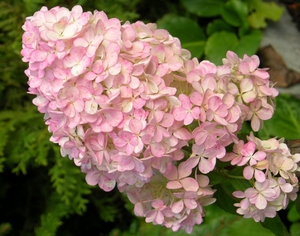 I would like to remind once again that all paniculate hydrangeas are unpretentious in care, so they can be successfully grown in illuminated areas and in conditions of partial shading. Vanilla Freize is no exception. But still growing this perennial in the sun is less preferable due to the fact that in such conditions it will grow much slower than in the shade. This will manifest itself in the summer, when by this time the bush will still look undersized, and the inflorescences will be small. At the same time, one must not forget that limestone soil should not be present at the chosen place for growing Vanilla Freise hydrangea.
I would like to remind once again that all paniculate hydrangeas are unpretentious in care, so they can be successfully grown in illuminated areas and in conditions of partial shading. Vanilla Freize is no exception. But still growing this perennial in the sun is less preferable due to the fact that in such conditions it will grow much slower than in the shade. This will manifest itself in the summer, when by this time the bush will still look undersized, and the inflorescences will be small. At the same time, one must not forget that limestone soil should not be present at the chosen place for growing Vanilla Freise hydrangea.
You can get the joy of growing this plant if you choose a site for planting that meets certain requirements:
- slightly acidic or neutral reaction;
- fertile and loose structure;
- the presence of organic fertilizers in the composition;
- moderate and regular hydration.
Growing hydrangeas in a shady area is a good idea. However, you will have to regularly loosen the hydrangea root zone. If you want to save yourself from such a laborious work, then you can do it easier and cover the surface layer with a small amount of mulch you have available.
How to feed?
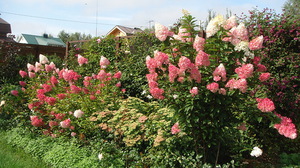 The first feeding is carried out at the end of May: it is recommended to use organic and mineral fertilizers. In their absence, you can use complex fertilizers. The next time fertilization is applied in a few weeks, because at this stage of the life cycle, plants need more nutrients to form flower buds for the next season.
The first feeding is carried out at the end of May: it is recommended to use organic and mineral fertilizers. In their absence, you can use complex fertilizers. The next time fertilization is applied in a few weeks, because at this stage of the life cycle, plants need more nutrients to form flower buds for the next season.
Hydrangea bushes that have weakened after winter need nitrogen-rich fertilizers, which are applied in spring. In the summer, top dressing is carried out using a solution of settled and fermented grass.It can be replaced with specialized hydrangea fertilizers. In the absence of such you can buy compositionsintended for rhododendrons or azaleas. Top dressing continues in late summer and early autumn - at this time of the year, superphosphate is used as fertilizer.
Water mode
All types of panicle hydrangea feel comfortable on wet soils. Therefore, if you want to enjoy an unforgettable bloom every season, you should keep the topsoil from drying out. The easiest way to achieve this is through mulching. area around the root zone, using rotted sawdust or peat as material. On hot days in summer, it is necessary to increase watering, spending 30-50 liters per plant. This irrigation should be done twice a week. If the temperature in the summer does not rise to critical levels, then you can limit yourself to watering, which is carried out once a week.
How and when to prune?
In the process of caring for panicle hydrangea, it is necessary to carry out such an event as pruning. It is usually planned in the spring.
After pruning, at least 5-10 shoots should remain on each bush, so you will have to remove 2-5 buds. It must be borne in mind that the nature of pruning shoots can affect what size and how many inflorescences appear in the summer season.
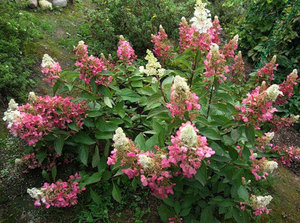 if you decide to remove the shoots two pairs of buds below the wilted flower, this will lead to the formation of a large number of small flowers;
if you decide to remove the shoots two pairs of buds below the wilted flower, this will lead to the formation of a large number of small flowers;- if, after pruning, two pairs of buds remain on the branch, then the number of flower brushes will be small, however, the flowers themselves will turn out to be large.
During pruning, do not leave dry inflorescences, since after their removal, new flowers will begin to form for the next season.
Conclusion
Hydrangea is one of the most common ornamental plants with which many domestic gardeners are familiar. Many are attracted by the rich color palette in this flower., not to mention that it is quite easy to care for hydrangea.
The panicle hydrangea Vanilla Freyz, which has absorbed all the properties of its family, seems to be very interesting. Therefore, when planting this variety, it must be borne in mind that it will be best blooming only in partial shade.... It is also necessary to pay attention to the correct preparation of the site for planting: it must be fertilized so that young seedlings can quickly take root and take root.


